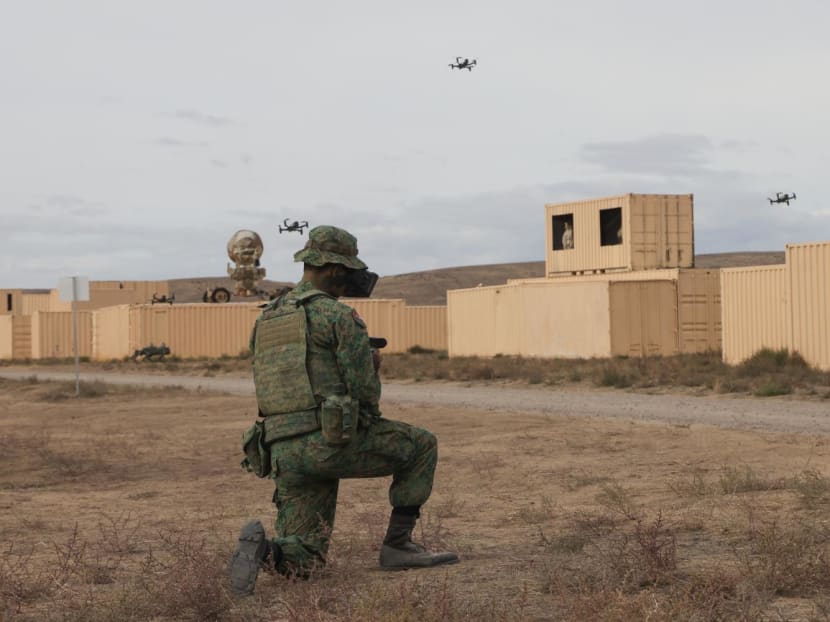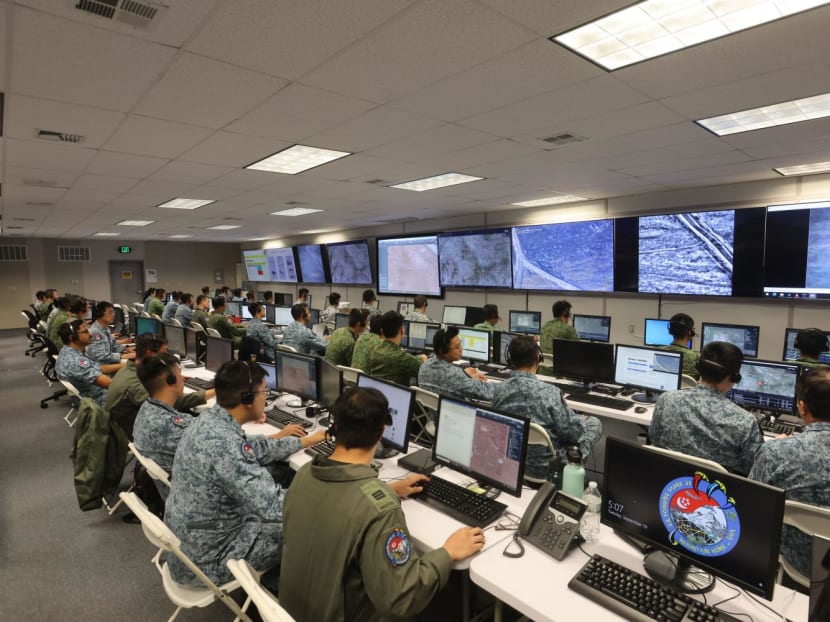Commentary: From drone swarm to AI — how the SAF is testing future warfare systems, including at Exercise Forging Sabre
When the Ukraine War first broke out in February 2022, videos circulating online showed numerous Russian tanks being targeted from the skies by Ukraine’s military unmanned aerial vehicles.

The Singapore Armed Forces using drone swarm technologies at Exercise Forging Sabre in Idaho, United States, from Sept 11 to 30. Drone swarm refers to the ability of a group of drones to autonomously coordinate as a team to achieve a mission objective, such as area surveillance.
When the Ukraine War first broke out in February 2022, videos circulating online showed numerous Russian tanks being targeted from the skies by Ukraine’s military unmanned aerial vehicles.
As the war continued, commercially-available drones from Ukraine, and later Russia, joined the battle, providing ground forces with cost-effective visual intelligence about enemy positions hidden in villages and trenches.
This intelligence is then closely followed by artillery or missile strikes, effectively eliminating the targets.
Such scenarios have been played out numerous times during the war, showcasing a never-before-seen concept of operation consisting of a mix between high-end military equipment and commercially-available systems which could be quickly modified and adapted for military use.
The rapidly evolving nature of commercial technologies is now driving military technology development.
WHAT SINGAPORE IS DOING
The Singapore Armed Forces (SAF) is now stress testing its developments of these tactical unmanned systems and assessing how they fit into the greater warfighting machine.
This was the main thrust of the 9th iteration of Exercise Forging Sabre (XFS) in Idaho, United States, involving 1,100 SAF personnel from Sept 11 to 30.
While the defence community regularly conducts tests in Singapore and other smaller exercises, the proof-of-concept nature of XFS gives military planners and scientists the opportunity to continuously develop these systems alongside conventional warfighting platforms such as fighter jets and helicopters, receive feedback from the upper echelons on their performance, all while doing so in the vast training areas in Idaho.
Started in 2005, the unilateral exercise has evolved from a small scale integrated strike exercise with just 300 personnel into a complex, multi-domain strike wargame, blending conventional strike capabilities such as fighter jets with innovative concepts like drone swarm and Industry 4.0 technologies like machine learning.
Smaller drones made their debut at XFS 2021, but it is the first time they are deployed at such scale and operating concepts.
Sometimes imagined as a wave of small drones, drone swarm also refers to the drones’ ability to autonomously coordinate as a team to achieve a mission objective, such as area surveillance.
The Republic of Singapore Air Force (RSAF) and the Defence Science and Technology Agency (DSTA) are experimenting with the application of drone swarm for battlefield intelligence.
These drones can survey and map out areas of interest, including identifying targets hidden in buildings, away from the eyes of a Heron 1 unmanned aerial vehicle that is looking from a top-down perspective.
Therefore this added intelligence provides the SAF command post with a comprehensive set of information to execute its strikes.
Similarly, the Army is exploring autonomous robodogs and drone teams, tactically employed for building searches and even vehicle tracking of interests. These unmanned systems keep operators out of harm’s way while maximising swarm technology to rapidly gather intelligence.
These swarming algorithms are tested in the Forging Sabre “sandbox”, where operators evaluate them, engineers make on-the-spot improvements, and the process repeats.
Some of these technologies were mere proof of concepts years ago, but their application in Ukraine has spurred SAF planners to pursue these ideas.

RAPID DECISIONS, RAPID STRIKES
Beyond drones and hardware, key developments are also made in the command-and-control systems, now powered by artificial intelligence (AI).
At XFS, the improved Command-and-Control Information System is also stress tested at the battle staff level, aimed to reduce the command post’s cognitive load and shorten decision making time.
In modern warfare, the process of sense and strike, sometimes referred to as the “kill chain”, is now reduced to minutes or even seconds as the battlefield evolves into a dynamic environment.
An increasingly urbanised battlefield means that these targets may hide in or around buildings to evade the watchful eyes of high-flying unmanned aerial vehicles, sometimes positioning themselves near sensitive structures like schools, hospitals, and religious sites.
At the command post, computer vision technology quickly detects and classifies targets from the drone sensors, automatically plotting them into the Command-and-Control Information System.
The system processes these massive volumes of data and information, recommending the most suitable assets in the area to engage the target, yet minimising collateral damage with new predictive tools.
With a click, the “strike order” is digitally transmitted to the asset, akin to a computer game of “Command and Conquer”.
To enhance stealth and surprise, these orders are transmitted via encrypted datalink.
Datalink is like a flying internet for airborne assets to share important information such as targets and coordinates, and allowing missions to be conducted without the need for radio communication.
Datalink is displayed as images on the cockpit console, providing pilots with enhanced situational awareness as part of an integrated warfighting system.
This capability is further bolstered by the introduction of RSAF’s newly upgraded F-16 fighter jets equipped with Link-16 datalink, state-of-the-art active electronically scanned array radar, and new Global Positioning System and laser-guided Joint Direct Attack Munition capability, granting the F-16s unprecedented ground attack capabilities not seen since their delivery in 1998.
Now, with similar capabilities in the F-15SG fighter jets, SAF commanders have the flexibility to assign either fighter type for precision strikes using either the Joint Direct Attack Munition or laser-guided bombs.
THINK BIGGER
Successful trials in XFS will provide RSAF and DSTA engineers with greater confidence to further push the limits of the testing and adoption of tactical unmanned systems. After all, the complexity of XFS has continued to increase over the years.
These could include scaling up the size of the drone swarm from just a few to tens or even hundreds. Pushing the boundaries further, it could involve pairing different types of unmanned platforms or even manned and unmanned combinations between manned aircraft and drones.
Moreover, the development of network-centric warfare observed at XFS is also in preparation for the introduction of RSAF F-35B fighter jets in 2026.
Renowned for its advanced sensing and data capabilities, the lessons learned and technological advancements at XFS will enable the SAF to rapidly integrate the F-35 and fully harness its capabilities.
The Ukraine war underscores the vital role of rapid and agile adoption of technology in modern warfare.
A small armed force like Singapore's needs to continually leverage novel technologies such as autonomous systems and AI to complement its proven warfighting platforms, like the F-15SG and High Mobility Artillery Rocket System, and utilise technology to fight intelligently, save lives, and maintain a strategic edge over its potential foes.
ABOUT THE AUTHOR:
Chen Chuanren is a freelance defence journalist and contributes to publications such as Aviation Week and Shephard Media. He witnessed Exercise Forging Sabre in person in 2015, 2017 and 2023.









